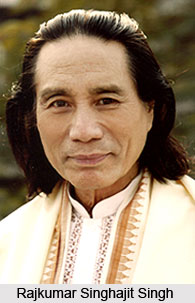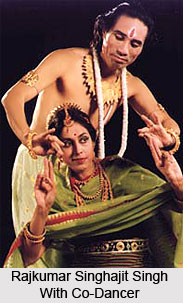 Rajkumar Singhajit Singh is a leading exponent of Manipuri dance styles. He was born on May 1, 1935, in a family of dancers and musicians in the state of Manipur. Early in life, Rajkumar Singhajit Singh was fortunate to receive his dance education from the finest gurus of Manipuri dance, like `Guru Ojha Iboton Singh` (1942-46) for Pung (drum), `Guru Thambal Angou Singh` (1950-52) - Kartal Chalom; followed by `Guru Amubi Singh` (1948-54) - Jagoi; `Guru Chauba Singh` (1952-53) - Kartal Chalom; and `Guru Ojha Gaura Singh` (1952-53). He also learned the martial arts with sword and spear and soon established himself as a dancer, choreographer and artist of repute all over India.
Rajkumar Singhajit Singh is a leading exponent of Manipuri dance styles. He was born on May 1, 1935, in a family of dancers and musicians in the state of Manipur. Early in life, Rajkumar Singhajit Singh was fortunate to receive his dance education from the finest gurus of Manipuri dance, like `Guru Ojha Iboton Singh` (1942-46) for Pung (drum), `Guru Thambal Angou Singh` (1950-52) - Kartal Chalom; followed by `Guru Amubi Singh` (1948-54) - Jagoi; `Guru Chauba Singh` (1952-53) - Kartal Chalom; and `Guru Ojha Gaura Singh` (1952-53). He also learned the martial arts with sword and spear and soon established himself as a dancer, choreographer and artist of repute all over India.
Rajkumar Singhajit Singh joined Triveni Kala Sangam, New Delhi, in 1954, as Head of the Manipur Dance Section, and later in 1962, established the `Triveni Ballet` of which he was the Director and Principal Dancer.
 With passing years, he and his dance troupe have extensively travelled to several countries in Europe, the former USSR, North and South America, Japan, West Asia and Africa.
With passing years, he and his dance troupe have extensively travelled to several countries in Europe, the former USSR, North and South America, Japan, West Asia and Africa.
Guru Singhajit Singh along with his wife Charu Sija Mathur, who is also a Sangeet Natak Akademi Award recipient, established, Manipuri Nrityashram, a Manipuri dance school, in New Delhi. Guru Singhajit Singh choreographed several Manipuri dance forms and is universally reckoned as the guru of Manipuri dance. He was honoured with the Sangeet Natak Akademi Award in 1984 and the Padma Shri in 1986 for his contribution to the Manipuri dance.
The prestigious awards received by Rajkumar Singhajit Singh are as follows -
•Doctor of Letters (hon) - North Eastern Hills University
•Homi Bhabha Fellowship (1976-1978)
•Sangeet Natak Akademi Award (1984)
•Padma Shri (1986)
•Nritya Choodamani from Chennai
•Delhi Sahitya Kala Parishad Award (1975)
•Fellow of Manipur State Kala Academy
•Manipur Sahitya Parishad Nritya Award (1975)



















